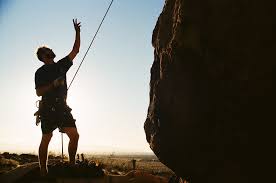|
Welcome to the exhilarating world of climbing! Whether you’re a seasoned climber or a newbie taking your first steps up the wall, understanding the art of belaying is crucial for a safe and enjoyable experience. In this blog, we’ll delve into what belaying is, why it’s important, and share some friendly tips to help you become a belaying pro. Let’s get started!
|

What is Belaying?
|
Belaying is a fundamental technique in climbing where one person, the belayer, manages the rope for the climber. The belayer’s job is to catch the climber if they fall, control the rope during the climb, and lower the climber back to the ground safely. It’s a partnership that requires trust, communication, and skill.
|

Why is Belaying Important?
|
Safety is the primary reason belaying is so crucial. A well-trained belayer can prevent accidents and ensure that the climber can push their limits with confidence. Good belaying also enhances the overall climbing experience by providing the climber with the necessary support and encouragement.
|/

Tips for Becoming a Great Belayer
|
Get Proper Training:
- No other tip on this list will be as essential as starting with a belaying course at a certified climbing gym. Professional instruction will provide you with the foundational skills and safety procedures you need.
Communicate Clearly:
- Clear communication between the climber and belayer is essential. Use standard commands like “On belay?” and “Climbing!” to ensure both parties are on the same page.
Pay Attention:
- Stay focused on the climber at all times. Avoid distractions and be ready to act quickly if the climber falls or needs assistance.
Master Rope Management:
- Learn how to properly manage slack in the rope. Too much slack can lead to a longer fall, while too little can hinder the climber’s movement.
Use Proper Gear:
- Ensure you’re using the right belay device and that all equipment is in good condition. Regularly check for wear and tear on ropes, harnesses, and carabiners.
Practice, Practice, Practice:
- Belaying, like climbing, improves with practice. Spend time belaying different climbers to get a feel for different climbing styles and situations.
Stay Physically Prepared:
- Belaying can be physically demanding. Strengthen your core and arms to handle the physical aspects of belaying effectively.
Be Patient and Encouraging:
- Support your climber with patience and positive reinforcement. A good belayer helps build the climber’s confidence and morale.
|

Common Belaying Mistakes to Avoid
|
Not Paying Attention:
- Always keep your eyes on the climber. Distractions can lead to delayed reactions in critical moments.
Improper Use of Belay Device
- Make sure you’re familiar with the belay device you’re using.
|

The Different Types of Belay
|
Assisted Blocking – PETZL Grigri Mod. D13A Grigio
- The PETZL Grigri Mod. D13A Grigio is an excellent belay device, especially for learning and intensive use, thanks to its cam-assisted blocking and anti-panic handle. The cam automatically engages to block the rope during a fall, enhancing safety and making belaying more comfortable. The anti-panic handle further ensures controlled descents, stopping the rope if the handle is pulled too hard, which is particularly beneficial for beginners. Compatible with a wide range of rope sizes and optimized for 8.9 to 10.5 mm ropes, this durable device is versatile and user-friendly, making it ideal for both new and experienced climbers.
Non-Assisted Blocking – PETZL Sicherungsgerät REVERSO
- The PETZL Reverso is a versatile and lightweight belay and rappel device designed for a wide range of climbing activities. It is compatible with various dynamic rope diameters, making it suitable for single, half, and twin ropes. The device’s V-shaped friction grooves allow for controlled braking, making it safe and efficient for both feeding slack and catching falls using standard belay techniques. Its ability to be used in Reverso mode to belay one or two followers from an anchor adds to its versatility, making it ideal for single-pitch climbs, multi-pitch routes, and mountaineering. This adaptability, combined with its lightweight design, makes the Reverso a valuable tool for climbers in various scenarios.
